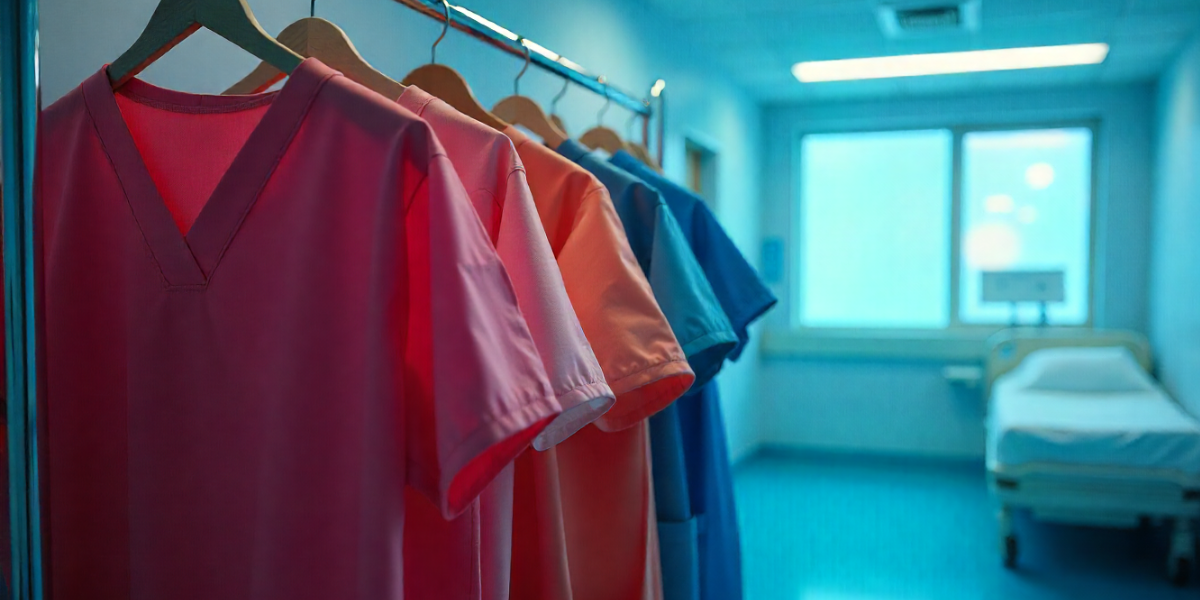Colors can be very impactful, and it’s not just about the fashion industry, but in healthcare, too. How, you may ask?
Well, the color in healthcare uniforms can shape the experiences of the patients and staff. Be it calming blues or energizing greens, the colors are a serious subject.
Today, when you are discussing uniforms with hospital uniform manufacturers, you must learn about the psychology of colors.
Let us help you understand it in this article.
Why the Psychology of Color in Healthcare Uniforms matter?
Colors have strong psychological connotations. Patients frequently arrive in the healthcare setting feeling exposed, nervous, or even afraid. These feelings are lessened by the psychology of color in healthcare uniforms, which fosters a comforting and nurturing atmosphere.
For instance, darker hues may imply authority and competence, while lighter shades often communicate cleanliness and safety. Healthcare uniform color selection can greatly enhance patient perceptions, promote improved communication, and lower stress levels.
Studies reveal that the perception of medical staff professionalism is also influenced by color. White uniforms were once thought to be a sign of sterility and purity, but because of their connection to “white coat syndrome,” hospitals are now looking into softer, less frightening alternatives.
This change illustrates how patients’ emotional comfort and sense of well-being are strongly related to the impact of uniform colors.
Common Colors and Their Psychological Effects
Blues, greens, and neutrals are popular choices in healthcare uniforms. Each has a unique psychological effect:
- Blue: Blue is a popular color for hospital uniform scrubs because it encourages peace and tranquility. It is associated with trust, dependability, and order, elements that are critical for health care providers. Blue tones are a popular choice in clinics and hospitals because they help patients feel less anxious.
- Green: Green is another color that is often used in medical settings and is frequently connected to healing and renewal. It has been demonstrated to lessen eye strain, which is particularly helpful for staff members and surgeons who spend a lot of time working in bright lighting. Green is also seen by patients as a representation of balance and healing.
- White: White has long been associated with authority, sterility, and cleanliness in medical uniforms. However, excessive use may make some patients feel cold or intimidated, which is why many medical facilities now only use white for lab coats instead of regular scrubs.
- Pastel Shades: In maternity or pediatric wards, light pinks, purples, and beiges are being used more and more. For vulnerable patient groups, these gentler tones provide a reassuring atmosphere because they seem caring and non-threatening.

The environment and patient demographics frequently determine the best colors for healthcare uniforms. For instance, cheerful colors are beneficial in pediatric hospitals, but surgical teams might favor green or blue for psychological and practical reasons.
The Impact of Uniform Colors on Patients
Uniform colors have an effect on patients that goes beyond aesthetics. Brighter yet professional colors encourage approachability and trust, while darker or overly clinical clothing may make patients feel less comfortable, according to studies.
Children’s fear of medical procedures can be lessened by wearing colorful uniforms with gentle colors or amiable prints, which makes the hospital stay less intimidating.
Conversely, older patients might react better to softer, more recognizable hues than to bright ones. This demonstrates how interactions and results can be improved by customizing the color in the healthcare uniform to the target patient demographic.
Does it Affect Staff Morale and Professional Identity?
Uniform colors have an effect on employees as well as patients. A sense of pride and belonging can be increased by donning colors that complement the institution’s ideals.
Some hospitals, for instance, designate distinct colors for each department, which helps employees recognize one another and strengthens team identity. Additionally, uplifting colors can help workers who work long, demanding shifts feel less stressed.
In order to create scrubs that strike a balance between comfort, durability, and color psychology, healthcare providers are increasingly collaborating with uniform manufacturers in the UAE as well as international suppliers.
Modern uniforms are developing into instruments that enhance staff wellbeing and patient care by fusing psychological understanding with pragmatic requirements.
How Uniform Manufacturers are Shaping Healthcare Environments?
Many facilities are looking to uniform suppliers in the UAE and other regions for high-quality solutions as the demand for customized and color-specific clothing grows.
These vendors provide customization that complements departmental requirements and institutional branding because they are aware of the psychological effects that color has on both patients and employees when it comes to healthcare uniforms.
Hospitals wishing to buy customized uniforms in the UAE often seek advice from designers to ensure the chosen colors convey professionalism and compassion. Bulk scrub orders, like bulk hospital scrubs in the UAE, enable facilities to keep teams uniform while making sure that color selections take psychological factors into account.
Prominent hospital uniform manufacturers now combine carefully chosen color schemes with cutting-edge fabric technologies, such as breathable, antimicrobial, and stain-resistant materials. This combination guarantees that uniforms contribute to a positive healthcare environment in addition to meeting safety and hygienic standards.
Choosing the Best Colors for Healthcare Uniforms
Three important factors should be taken into account by decision-makers when choosing the ideal colors for healthcare uniforms:
- Patient Demographics: While geriatric care often calls for calming neutrals, pediatric wards may benefit from bright colors.
- Departmental Needs: Administrative employees may dress professionally in shades like grey or navy, while surgical teams may need to wear functional greens and blues.
- Institutional Identity: Colors can establish uniformity throughout facilities and strengthen branding.
Healthcare organizations can guarantee that uniforms serve both functional purposes and the deeper psychological needs of both employees and patients by striking a balance between these factors.

Conclusion
The psychology of color in healthcare uniforms goes far beyond aesthetics—it plays a critical role in shaping patient comfort, staff morale, and institutional identity. Choosing the right shades can ease anxiety, promote healing, and foster professionalism.
Today, leading providers like Silver Thread UAE are helping healthcare facilities design uniforms that merge science-backed color choices with modern fabric technologies.
Our customized solutions ensure both staff and patients benefit from a supportive, positive environment. By working with expert uniform manufacturers, healthcare institutions can turn uniforms into powerful tools for care, trust, and connection.
FAQs
1. How does the psychology of color in healthcare uniforms affect patient comfort?
The psychology of color in healthcare uniforms helps reduce patient stress, creates a welcoming environment, and fosters reassurance by using calming tones like blue and green that promote healing, trust, and overall comfort.
2. What are the best colors for healthcare uniforms to build trust with patients?
Blue and green healthcare uniforms build trust by symbolizing calmness, stability, and renewal. Softer pastel shades also help in pediatric or maternity care, ensuring patients feel comfortable, cared for, and connected to the staff.
3. Does the psychology of color in healthcare uniforms influence staff performance?
Yes, uniform colors impact staff morale and focus. Uplifting shades reduce stress, departmental color coding improves teamwork, and psychologically supportive tones help healthcare professionals stay motivated, productive, and aligned with institutional identity.

